GUT PLANTING
/16 Comments/in Gardening, Vegetables/by Lee ReichNot My Usual Approach
I couldn’t help myself, so yesterday I broke protocol. After quite a few days of bright sunshine with daytime temperatures in the 70s, even the 80s a couple of days, I went ahead and planted all the tomato and pepper plants that I’ve been nurturing since their birth a few weeks ago — six weeks for the tomatoes, ten weeks for the peppers. Looking ahead, warm sunny days should follow, with night temperatures are predicted to dip down only into the 50s.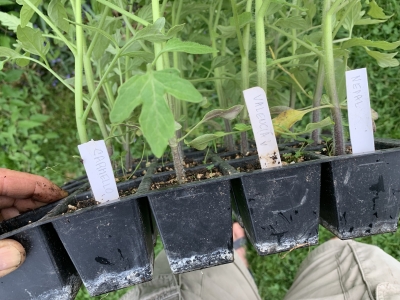
My usual protocol has been to plant not with my gut, but with the calendar date. Over the years I’m come up with a detailed chart of when to sow and transplant different kinds of vegetables based on the average dates of the last killing frost. Here, that date is around May 21st. Or, it used to be. (That chart — which I included in my book Weedless Gardening — allows anyone anywhere to determine sowing and planting dates merely by plugging in the average date for the last killing frost for their garden. Last frost dates for specific locations are available online.)
As with other global warming trends, the average date of the last killing frost right here — meaning specifically in my garden, which is in a frost pocket — has been pushed back a week or more. In the past, I would wait until a week, even two weeks, after that last frost date to set tomato and pepper plants in the garden. The average frost date is just an average; that week or two made sure my plants wouldn’t be caught off guard by a clear, cold night that didn’t hew to averages and charts.
When it comes right down to it, early planting is a gamble. The odds were good, so I took the gamble. My actions were also shaded by my not wanting to repot all the seedlings that were soon to outgrow their containers, and my hankering to see my garden with lots of plants in it.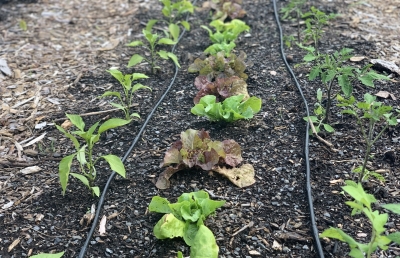
Frost or Freeze
The word “frost” allows for some wiggle room. You’d think it meant any temperature below 32 degrees Fahrenheit. Not so. Temperatures between 29 and 32 degrees could be called a “light freeze.” Peppers and tomatoes sufficiently toughened up (“hardened off”) with some exposure to bright sunlight, cool temperatures, and wind can cruise right through a light freeze unscathed.
Moderate freezes, 25 to 28 degrees F., would cause some damage. A severe freeze, with temperatures below 24 degrees F. spells trouble for any tender vegetables plant. Sufficiently hardened off cool season plants, such as cabbage and its kin, lettuce, and chard, are usually fine even at those temperatures.
In all this, whether or not damage or death occur must factor in how fast cold descends on the garden, and how long it sits around.
At this point, I’m confident that my plants will be fine. If Ol’ Man Winter decides to peek in again, I can always throw a cover — flower pots, sheets, row cover — over the plants to protect them from cold.
Upright Pepper Plants
Let’s shift gears and take a look at growing peppers, specifically, keeping them upright. My pepper plants, and perhaps yours, become top heavy with their weight of maturing fruit. Mine especially so because I don’t pick any until they have fully matured, turning red or whatever other color they sport at full maturity. Especially prone to toppling is the variety Sweet Italia, which I grow because of its especially luscious fruits which also ripen early.
I’ve tried various methods of keeping Sweet Italia’s fruit laden stems up. In the past, I grew them in those cone shaped, wire cages often sold for tomatoes, for which they are useless. Those cages get tangled together in storage and make weeding very difficult. My bamboo provides an excess of stakes of various thickness; three stakes next to a plant does keep the plant upright, but not its fruit-laden arms.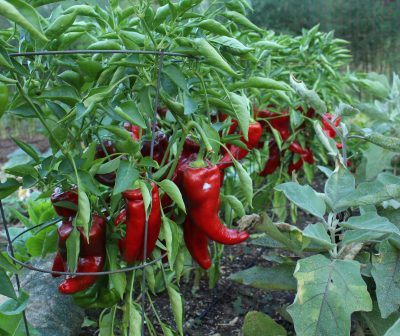
Twine woven in among the plants and tied to metal stakes set a few feet apart along the row held plants and most arms up, but scrunched everything together too much, cutting down light penetration.
This year my plants are going to stand up with the help of livestock fencing panels, cattle panels with 6×8 inch openings, and goat and sheep panels with 4×4 inch openings. With a bolt cutter I clipped them into one-square-wide strips. Each bed is home to two rows, about 20 inches apart, of peppers, with plants set 16 inches apart in the row. Sixteen inch spacing allows me to set the panel strips centered over the plants. For now the strips are on the ground beneath the plants.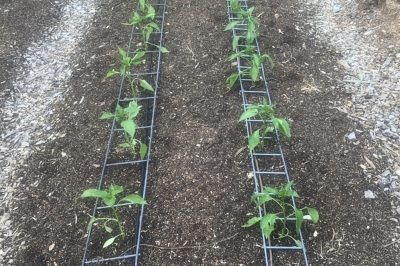
Once the plants grow large and start extending their arms, I’ll raise the strips with some bricks set every few feet as high as needed to do their job.
I hope this works, and welcome any comments on the prognosis. Do you have a method for successfully keeping your peppers from toppling or resting too many fruits on the ground? Perhaps your peppers grow unaided?
A WEBINAR AND A PLANT SALE
/2 Comments/in Gardening/by Lee ReichWebinar: GROWING FIGS IN COLD CLIMATES
Harvesting your own fresh figs, which offer a very different gustatory experience from dried figs, is possible and easy even if you live where winters are cold. Even where summers remain cool. Once you know why fig allows this, various methods can lead you to fig-dom. I’ll cover the why, some of the methods, and detail the all-important methods of pruning.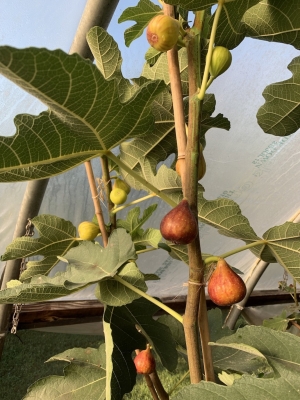
Date and Time: Monday, June 6, 2022, 7-9 pm Eastern Time
Cost: $35
Space is limited and registration is necessary. Register and pay (credit card or Paypal) here, or at:
https://us02web.zoom.us/webinar/register/WN_4hqKduDNSyiuRGPBlmBObg
Contact me if you’d prefer to pay by check.
Plant Sale
This year the 14th(?) Annual Plant Sale will be held live, here at Springtown Farmden. Plants, available in limited quantities, include mostly fruit plants, including Nanking cherries, grapes, hardy kiwifruit, lowbush blueberry, highbush blueberry, hardy orange, and, of course, figs.
This year, there’ll also be lots of books (in addition to the ones I wrote), some for sale and some free. The books cover a wide range of gardening topics.
Date and Time: June 12, 2022, 9:30 AM – 1:00 PM
Location: Springtown Farmden in New Paltz, NY
Note: You must be (correctly) masked to attend this live sale.

SPRING SEEDING: WHEN?
/4 Comments/in Vegetables/by Lee ReichTruth From a Thermometer
Stop by my vegetable garden this time of year and you might see one or more thermometers poking out of the ground. No, I’m not experimenting with a new way to monitor the soil’s health. Soil temperature can serve as a guide for timely sowing of seeds outdoors. Seed sown in soil that is too cold won’t germinate; just sitting there waiting for warmer weather, ungerminated seeds are liable to rot or be eaten by animals.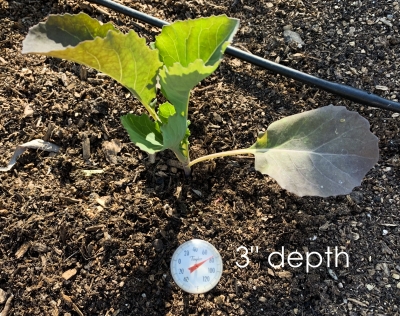
Lettuce, onion, parsnip, and spinach seeds can be planted earliest. They’ll germinate just about as soon as ice in the soil thaws. At the other end of the spectrum are seeds of melons and squash, which won’t germinate until the soil temperature reaches sixty-five degrees. The minimum temperature required for germination of other vegetable seeds is as follows: forty degrees for beets, cabbage and its kin, carrots, peas, chard, parsley, celery, and radishes; fifty degrees for sweet corn and turnips; and sixty degrees for beans, cucumbers, and okra.
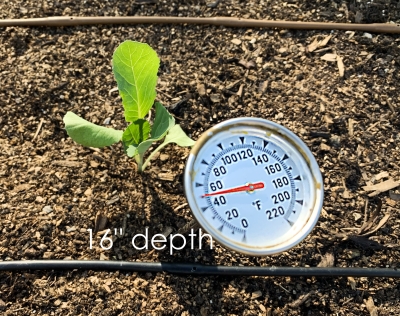 The above listing gives minimum, not optimum, temperatures for germination. Optimum temperatures might be even thirty degrees higher than the minimums, as in the case of celery which germinates quickest at seventy degrees. Waiting for the optimum temperature isn’t advisable, though. To delay sowing until the soil temperature reached the optimum temperature for pea germination (seventy-five degrees) would result in a midsummer harvest, when hot, dry weather turns peas coarse in taste and texture.
The above listing gives minimum, not optimum, temperatures for germination. Optimum temperatures might be even thirty degrees higher than the minimums, as in the case of celery which germinates quickest at seventy degrees. Waiting for the optimum temperature isn’t advisable, though. To delay sowing until the soil temperature reached the optimum temperature for pea germination (seventy-five degrees) would result in a midsummer harvest, when hot, dry weather turns peas coarse in taste and texture.
But What Temperature is Best?
For indoor seeding in seed flats, I use an electric, thermostatically controlled heating mat, waterproof and made for seed germination. With so many different kinds of seeds to grow, I can’t be twisting the thermostat dial up and down to suit each seed’s optimum. The temperature remains set at about 80 degrees. Which is why lettuce sown a couple of weeks ago still hasn’t sprouted.
Each kind of seed also has a maximum temperature at which it will sprout. For lettuce, that’s about 80 degrees. I resowed a few days ago, setting the lettuce flat on the cooler greenhouse bench instead of the mat, and green leaves have already shown their faces. Other vegetable seeds notorious for sulking in the heat are parsnip, celery, and pea. Turnip is interesting for being eager to sprout anywhere in the broad range of 60 to 105 degrees!
For more details on temperatures needed for seed germination, as well as plant growing and charts and tables with lots of other stuff about growing vegetables, I highly recommend Knott’s Handbook for Vegetable Growers, available in hard copy or online.
Tips to Advance the Season
No need to twiddle your thumbs waiting for the soil to warm; the warming process can be speeded up. (I detail a number of ways to do this in my book Weedless Gardening.) A thick, organic mulch, though generally beneficial to the soil, insulates the soil and hence delays warming this time of year. So for early sowings, rake back the mulch to expose the soil to the sun. Once the soil is warm — about mid-June — replace the mulch to recoup its benefits.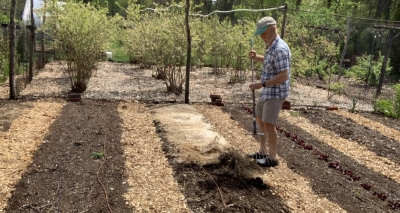
Where soil is not blanketed with mulch, warming can be hastened by forming small ridges oriented east and west. You plant seeds on the south faces of these ridges. With sunlight beaming directly down on these south-facing ridges, the soil there warms a bit faster than the surrounding soil. 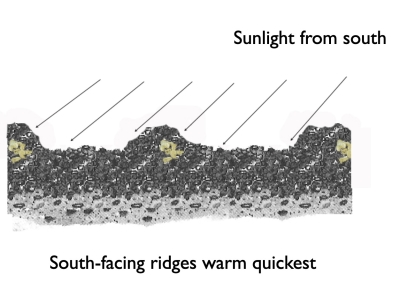 (For the same reason, here in the Northern Hemisphere, south-facing slopes are warmer than north-facing slopes. North-facing slopes ideal for planting peaches and apricots to delay their flowers to when there’s less possibility of a later spring frost snuffing them out.)
(For the same reason, here in the Northern Hemisphere, south-facing slopes are warmer than north-facing slopes. North-facing slopes ideal for planting peaches and apricots to delay their flowers to when there’s less possibility of a later spring frost snuffing them out.)
Another way to warm the ground for early spring planting is to grow plants in raised beds. In raised beds the soil warms early because it’s more exposed to ambient air temperatures. Raised beds are well-drained, so dry more quickly; it takes more heat to warm a wet soil than a dry soil.
Changing the color of the soil surface affects its temperature. Black plastic mulch is unsightly, but it does warm the soil. Hide the plastic’s ugliness with a layer of bark chips and the plastic’s warming effect will be lost. In climates such as ours, where the soil is just marginally warm enough for vegetables like peppers, melons, and eggplants even in summer, the plastic mulch improves growth if left in place the whole season.
A top layer of compost on the ground darkens the soil in a more attractive manner than black plastic, though the effect on soil temperature is less dramatic. Compost does, of course, confer other benefits to the soil, such as improving the soil’s physical structure and providing essential nutrients. These benefits are lacking with black plastic.
Natural Indicators
All these techniques warm the soil a little faster than it would otherwise. You can measure the effect with a soil thermometer, but a thermometer is not mandatory for determining when to sow seeds. The soil slowly but surely warms up at about the same rate each spring, so you can sow by calendar dates, subtracting a few days if you deliberately hasten soil-warming. 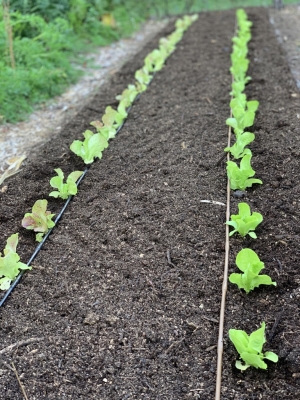
Since the soil temperature and spring blossoms are influenced by the same general warming trend, even better is to sow seeds according to what perennial or woody plants are in bloom. For instance, you might plant peas just as the forsythias blossom, and corn according to the traditional indicator — when oak leaves are the size of mouse ears. A soil thermometer should register about forty degrees in the first case, and fifty degrees in the second.

